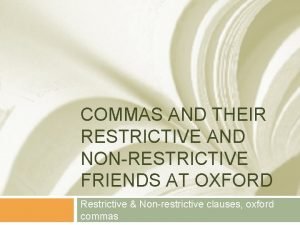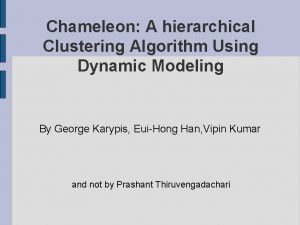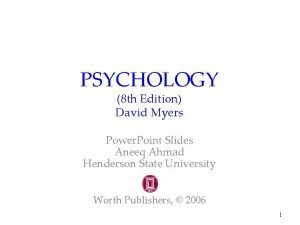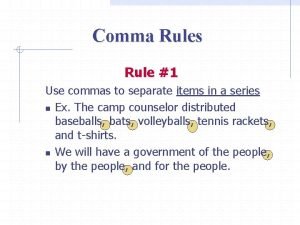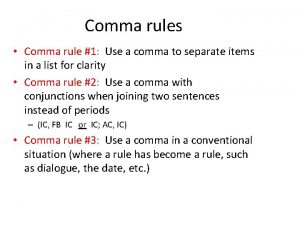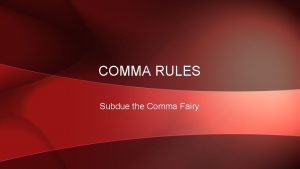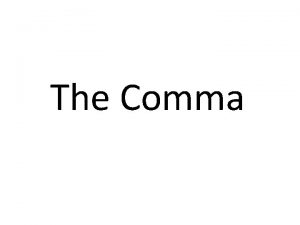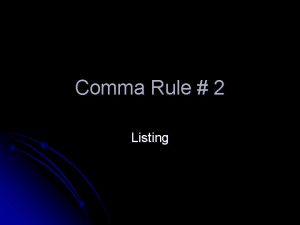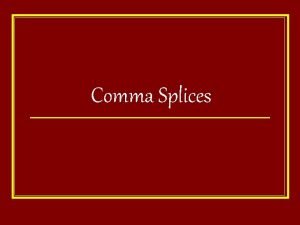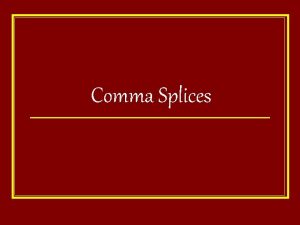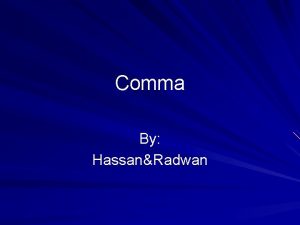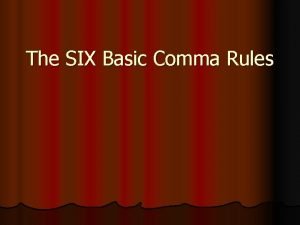Comma comma comma Comma chameleon Rule 1 Use











- Slides: 11

Comma, comma, comma (Comma chameleon…)

Rule 1: Use a comma to separate coordinate (equal) adjectives that describe the same noun. • You can decide if two adjectives in a row are coordinate by asking the following questions: – Does the sentence make sense if the adjectives are written in reverse order? – Does the sentence make sense if the adjectives are written with and between them? • Examples: – He was a difficult, stubborn child. (coordinate) – They lived in a white frame house. (non-coordinate) – She often wore a gray wool shawl. (non-coordinate) – Your cousin has an easy, happy smile. (coordinate)

Practice • We were prepared for a long tedious planning session. • We were prepared for a long, tedious planning session. • Allen owns several blue knit socks. • In order to get home, we must travel over several narrow winding treacherous roads. • In order to get home, we must travel over several narrow, winding, treacherous roads.

Rule 2: Use a pair of commas in the middle of a sentence to set off clauses, phrases, and words that are not essential to the meaning of the sentence. • Here are some clues to help you decide whether the sentence element is essential: – If you leave out the clause, phrase, or word, does the sentence still make sense? – Does the clause, phrase, or word interrupt the flow of words in the original sentence? – If you move the element to a different position in the sentence, does the sentence still make sense? • Examples: – (Clause): That Tuesday, which happens to be my birthday, is the only day when I am available to meet. – (Phrase): This restaurant has an exciting atmosphere. The food, on the other hand, is rather bland. – (Word): I appreciate your hard work. In this case, however, you seem to have over-exerted yourself.

Practice • Patterson Tower the recently completed office building is a monument to concrete ugliness. • Patterson Tower, the recently completed office building, is a monument to concrete ugliness. • The movie that I wanted to see is no longer playing. • John decided nonetheless not to buy the car. • John decided, nonetheless, not to buy the car.

Rule 3: Use commas after introductory clauses, phrases, or words that come before the main clause. • Common starter words for introductory clauses that should be followed by a comma include after, although, as, because, if, since, when, while. • If the introductory phrase is a preposition with three words or fewer, a comma is NOT needed • Examples: – – While I was eating, the cat scratched at the door. Because her alarm clock was broken, she was late for class. If you are ill, you ought to see a doctor. When the snow stops falling, we'll shovel the driveway.

Practice • As the day drew to a smoky end the firefighters put out the last of the embers. • As the day drew to a smoky end, the firefighters put out the last of the embers. • By evening we had become impatient. • On the other hand someone obviously was badly injured. • On the other hand, someone obviously was badly injured.

Rule 4: Use commas to separate independent clauses when FANBOYS is used. DO NOT use a comma with dependent clauses. • An independent clause is one that can stand by itself because it contains both a subject and a predicate. A dependent clause has a subject OR a predicate, but not both. Examples: “the boy kicked the ball” = independent: boy = subject, kicked = predicate “ran around the block” = dependent: there is no subject “the man with the hat” = dependent: there is no predicate • The game was over, but the crowd refused to leave. • The student explained her question, yet the instructor still didn't seem to understand. • Yesterday was her brother's birthday, so she took him out to dinner.

• Incorrect sentences: – When the bell rings. (it is an incomplete thought) – I really like that dress the price is good, too. ( it is a run-on [fused] sentence) – Remember that one time, that our team won the championship? (unnecessary comma) – We went the club around the corner, it was open until 2 AM. (two independent clauses [comma splice], which means it needs a FANBOYS conjunction added)

Practice Jean does not each much lately and she is losing weight. Jean does not each much lately, and she is losing weight. The rain continued for an hour so the game was called off. The rain continued for an hour, so the game was called off. He would not let them fight nor would he allow them to give up. • He would not let them fight, nor would he allow them to give up. • I am considering a career in psychology, however I am not sure I will like the work. • I am considering a career in psychology; however, I am not sure I will like the work. • • •

• The concert will begin at noon and three sopranos will perform. • The concert will begin at noon, and three sopranos will perform. • He slammed the door before I could say anything. • Susan washed the dishes, Charlotte dried them. • Susan washed the dishes, and Charlotte dried them. • Everyone signs the petition. The bill will not become law. • Everyone signs the petition, but the bill will not become law.
